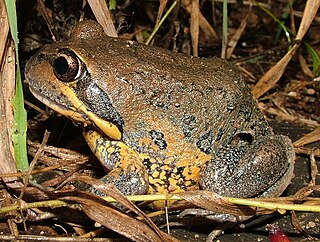
The broad-palmed frog is a species of ground-dwelling tree frog. It is native to much of eastern Australia. They can be found from mid-Queensland to south of Sydney. It is associated with the coast and inland, and is distributed as far west in New South Wales to the South Australia border.

The common eastern froglet is a very common, Australian ground-dwelling frog, of the family Myobatrachidae.

The giant barred frog is a species of barred frog found in Australia. It occurs from south-eastern Queensland to just south of the Newcastle region in New South Wales. It is associated with flowing streams and creeks in wet sclerophyll and rainforest habitats from the coast to the ranges.

The Tasmanian froglet is a species of ground-dwelling frog that occurs only in Tasmania, Australia.

The Red-backed Toadlet is a species of ground frog native to the coast and adjacent ranges of eastern Australia, from just north of Sydney to South-eastern Queensland.

The Blue Mountains tree frog also called the variegated river tree frog is a species of tree frog in the subfamily Pelodryadinae. It is endemic to southeastern Australia and is found in eastern Victoria and in southeastern New South Wales. The Jenolan Caves tree frog, a population formerly separated as Litoria jenolanensis, is nowadays included in this species.

The wallum froglet is a species of ground-dwelling frog native to the east coast of Australia, from southeast Queensland to Kurnell, NSW. It is strongly associated with Wallum swampland.

The southern leaf green tree frog is a species of tree frog native to coastal areas and the ranges of south-eastern Australia. It is distributed from just south of Sydney to eastern Victoria.

The leaf green tree frog is a species of stream-dwelling frog, native to eastern Australia from the Queensland/New South Wales border south to Sydney.

The Tasmanian tree frog, also known as king tree frog, is a species of tree frog that is found on the west coast of Tasmania, Australia. It was first found by Myrtle Burrows in 1941, at Cradle Mountain and handed over to Scott Oswald, who is attributed with the discovery.

Lesueur's frog is a species of ground-dwelling tree frog native to south-eastern Australia, from Sydney, New South Wales, to eastern Victoria.

Haswell's frog is a small ground frog found around coastal swamps in eastern Australia from around Port Macquarie, New South Wales to the Mornington Peninsula in Victoria. It is the only member of the genus Paracrinia.

Littlejohn's tree frog, also called a heath frog or orange-bellied tree frog, is a species of tree frog native to eastern Australia from Wyong, New South Wales, to Buchan, Victoria.

The striped burrowing frog is a species of burrowing frog in the subfamily Pelodryadinae of the family Hylidae. It occurs throughout much of Australia, from northern New South Wales, through eastern and northern Queensland and into eastern Northern Territory. This species was once included in the genus Litoria or Cyclorana.

Ranoidea australis, commonly known as the giant frog, northern snapping frog, or round frog, is a burrowing species of frog native to Australia. It occurs from western Queensland through to northern Western Australia.

The painted burrowing frog is a species of burrowing frog native to western Victoria, eastern South Australia and southern New South Wales. They are also one of six species of frog which inhabit Kangaroo Island.

The Sudell's frog, painted burrowing frog, trilling frog or desert trilling frog is a species of burrowing frog common to a large part of southeastern Australia. It is found on and west of the Great Dividing Range of New South Wales to western Victoria and southern Queensland as well as far eastern South Australia.

The Northern banjo frog is a species of ground-dwelling burrowing frogs native to eastern Queensland and northeastern New South Wales, Australia.

The rough frog, also known as the woodland water-holding frog, warty water-holding frog, and red-backed cyclorana, is a species of treefrog native to northern New South Wales and south-eastern Queensland, Australia.

The knife-footed frog is a species of burrowing frog in the family Hylidae. It is endemic to Australia, where it is found over a wide area in the north of the continent.






















